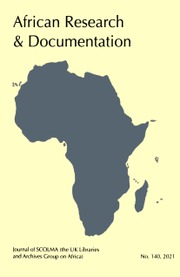No CrossRef data available.
Article contents
Constraints to the Use of Media and Information Technology in Selected Health Institutions in Nigeria
Published online by Cambridge University Press: 25 April 2022
Extract
Good health is a prerequisite to the socio-economic development of any community. According to the World Health Organization (WHO) (1988), health is defined as a state of complete physical, mental, and social well-being and not the mere absence of disease or infirmity. Education which plays an important role in achieving good health, however, is a complex and planned learning experience that aims to bring about changes in cognitive (knowledge), affective (attitude, belief and value) and psychomotor (skill) domains of behaviour (Yazachew and Alem, 2004). It is a combination of learning experiences designed to facilitate voluntary actions conducive to health. According to Fabiyi (2001), health education aims at encouraging people to adopt and sustain healthful life patterns, to use judiciously and wisely the health services available to them and use these to make their decisions, both individually and collectively to improve their health status and environment.
Information
- Type
- Other Articles
- Information
- Copyright
- Copyright © International African Institute 2016

